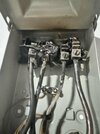You are right in BOTH sentences. I replied on old post because I found it the most relevant to my issue and I saw that people set $20 disconnect switches and after this surprised by seeing attached picture.Congrats for answering 4 year old posts in a thread last replied to 2 years ago, and getting your facts wrong. A 240v circuit is made up of two 120v phases, which makes it less than 150v to ground.
Regarding the 150V code requirement, you are absolutely right. I had a misguided haze when I wrote this.




